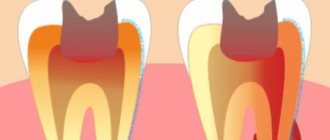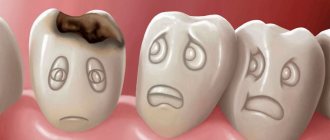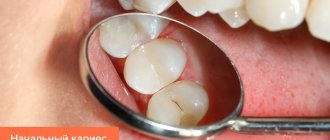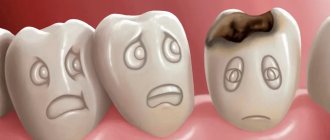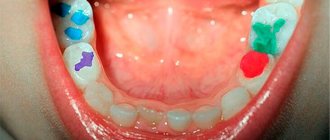Dental caries is the most common dental disease, affecting more than 90% of people worldwide. Caries, which is not treated on time, leads to tooth decay and severe complications, so if you notice any signs of this disease, do not delay and contact your dentist. Cervical caries has its own classification - according to the stage of development, as well as according to the location. If carious lesions affect the cervical part of the tooth, such dental caries is called cervical caries.
How does cervical caries differ from other forms of caries, and how is it treated in dentistry? We will talk about this in detail in this material! After reading the article, you will learn how cervical caries develops, what causes it, what methods are used to treat caries in this form and how much it costs to cure cervical caries in Moscow.
Calculate the cost of treatment by taking a short test in 20 seconds!
Do not delay your treatment, because in this matter time plays against us.
Cervical caries: what is it?
The neck of the tooth is the name given to the place where the tooth comes into contact with the gum. Caries that forms in this area is usually referred to as cervical caries, and it should be noted that this form of caries occurs quite often, because the enamel on the neck of the tooth is quite thin and vulnerable, insufficiently mineralized. Cervical caries occurs in people of all ages and the most common reason for its occurrence is irregular oral hygiene.
Cervical caries in the initial stages of development is quite difficult to notice, because it manifests itself as a small bright spot. Many people do not pay any attention to this spot until the tooth begins to hurt or the damage becomes more significant and noticeable. Meanwhile, it is necessary to start treating cervical caries urgently, because from the neck of the tooth the infection can easily get into the pulp and the inside of the tooth, and this is fraught with complications such as pulpitis and periodontitis.
USEFUL TO KNOW: Pulpitis and periodontitis are quite serious complications of caries that can lead to tooth loss. Treatment of these complications of cervical caries is an unpleasant, slow and quite expensive process, so never start caries and consult a doctor at the first sign!
How dangerous is the disease?
If cervical caries is not treated, the following complications may quickly appear:
- Pulpitis is an inflammation of the soft tissue (pulp) located in the dental cavity. The infection enters the pulp when hard tissue is destroyed. Symptoms: severe excruciating pain in the tooth, appearing regardless of food intake, including at night.
- Periodontitis is an inflammation of the ligament that holds the tooth root in the cell (periodontal). The infection enters the periodontium through the root canals. The pain becomes unbearable, often pulsating, and intensifies with chewing (mechanical irritation). Fever and general malaise appear.
- An abscess at the root apex is a capsule filled with pus. Severe pain, severe fever, chills.
- Osteomyelitis is an inflammation of the jaw bone. The condition is serious and urgent hospitalization is required.
- Periodontitis – inflammation spreads to the periodontal tissues, the gums become inflamed and bleed. Pockets form between the gum and neck, into which food becomes trapped, maintaining the infection. It is painful. Treatment takes a long time and is not always successful; much depends on the patient’s immunity.
- Lateral spread of infection to the necks of adjacent teeth, development of multiple caries.
- Circular lesion of the neck with crown fracture.
If you suspect the presence of a carious process under the gum, you should immediately contact your dentist: complications with this form of the disease develop very quickly!
Why does cervical caries appear and develop?
As we wrote above, the tooth enamel in the cervical area is quite thin and vulnerable, in addition, the cervical area of the tooth is quite difficult to properly clean from plaque during cleaning. And the remaining plaque is a favorable environment for the proliferation of different types of pathogenic microorganisms, including carious bacteria.
The vital activity of these bacteria leads to the active formation of lactic acid, which destroys tooth enamel and, as a result, cervical caries occurs. Also, the occurrence of cervical caries can be caused by the abuse of abrasive pastes, taking certain medications, and chronic general diseases of the body. An unbalanced diet can also be a factor provoking the development of cervical caries, therefore, even while following diets that are so fashionable these days, it is important to ensure that the body receives all the necessary vitamins and minerals!
Causes of the disease
The main cause of cervical caries is a bacterial infection that constantly lives in the oral cavity. If the crowns of the teeth are not completely cleared of food, then colonies of bacteria settle on them, forming soft and hard (tartar) plaque. Bacteria secrete enzymes that destroy tooth enamel and penetrate first deep into hard tissues and then into the dental cavity, affecting the pulp, root canals and moving onto the periodontium (the ligament that holds the tooth in the cell).
The localization of the carious process in the neck of the tooth determines the characteristics of its occurrence and course. This:
- the area with the thinnest layer of enamel - about 0.01 mm (average thickness in the crown area - 2 mm);
- the part of the tooth next to the gum is difficult to clean during daily hygiene procedures, so food debris accumulates in it, first soft and then hard plaque (tartar) is formed, destroying the gums, forming pockets between the gum and tooth, where even more food debris accumulates - it creates an ideal breeding ground for bacteria, and their waste products destroy the enamel;
- the neck is covered by the gum, so the onset of the carious process occurs unnoticed, the carious process is detected already at advanced stages, when the body signals it with pain;
- The pathological process proceeds very quickly with the development of complications.
Factors predisposing to the development of caries in the cervical region are:
- poor oral hygiene;
- frequent consumption of sweets without subsequent rinsing of the mouth;
- use of certain medications (glucocorticoids, antibiotics, etc.)
- smoking - poor circulation in the gums contributes to their inflammation and the formation of pockets between the gums and teeth where food gets stuck; smoking also destroys and stains enamel yellow;
- defects in the development of enamel - a thin layer or completely absent, slit-like depressions;
- immunity disorders;
- constant dry mouth, which develops for various reasons - saliva washes away bacteria;
- endocrine disorders of the thyroid and pancreas (diabetes mellitus);
- pregnancy - calcium is used to build fetal tissue.
- occupational hazards - persons at risk are those who work in industries with acids, heavy metals (lead, copper, brass), industrial dust and gases, sudden temperature changes, and infections.
- concomitant diseases - at risk are persons suffering from diabetes mellitus, thyroid diseases, dysfunction of the salivary glands, vitamin deficiency, as well as those with a family history (having close relatives with multiple or systemic caries).
Symptoms and types of cervical caries
Symptoms of cervical caries may vary depending on the stage of its development. Therefore, below we will consider the stages of development of cervical caries and describe the signs characteristic of each of them.
Cervical caries in the spot stage
At this phase of caries development, a small dark or light spot may appear in the cervical area of the tooth. The pain of the patient with cervical caries does not bother the spots.
Superficial cervical caries
At this stage of cervical caries, the surface layers of tooth enamel are destroyed. It may become rough and uneven to the touch. Increased sensitivity of the diseased tooth to temperature factors - too hot or cold food - may also occur.
Middle cervical caries
The carious lesion of the tooth increases in size, the dentin of the tooth becomes increasingly soft. But at the same time, the destructive process at this stage of cervical caries has not yet reached the pulp. A person may experience tooth pain when brushing their teeth or biting into food. But this pain goes away quite quickly, which is why people are in no hurry to treat caries, thinking that the tooth will go away on its own.
Deep cervical caries
Destruction at this stage of caries reaches the pulp and the risks of pulpitis become extremely high.
In a tooth with advanced caries, severe pain may occur when the tooth comes into contact with food. The tooth begins to hurt especially badly if a piece of food gets into the carious cavity. After eliminating the irritant, the pain may go away. Cervical caries also has another form, which dentists call circular caries. It affects several teeth in a row at once, and carious destruction runs along the tooth at the neck like a belt, that is, from all sides. It is very, very difficult to treat circular caries!
The form and stage of development of cervical caries are determined by the dentist during diagnostic measures.
Symptoms
A stain on a tooth is a sign of caries
First, if you look closely at the tooth, you can see a small white spot on its frontal surface near the gum. But very often it is covered by gums or tartar, so only a dentist can notice it (this is why it is so important to undergo medical examinations twice a year). The tooth doesn't hurt.
After this, thin enamel and dentin are destroyed quite quickly with infection penetrating into the pulp (soft tissue penetrated by nerve endings and blood vessels). This is a complicated carious process. A person experiences pain when eating cold, hot, sour and sweet foods. The pain is severe and does not go away immediately after rinsing.
The next thing that appears is severe throbbing pain, sometimes accompanied by an increase in body temperature - a sign of periodontitis. If it is not treated promptly, the infection can spread to the soft tissues and bones of the jaw.
How is cervical caries diagnosed?
If you are careful, you can determine for yourself whether you have cervical caries or not. To do this, you need to brush your teeth well and then carefully examine their cervical area in sufficient lighting. Any spots in the area of the neck of the tooth indicate that the tooth is affected by cervical caries, and it is urgently necessary to treat it.
In a clinical setting, not only visual examination, but also professional techniques are used to diagnose cervical caries. Among them:
Vital staining technique
This technique for diagnosing cervical caries involves cleaning dental surfaces from plaque, and then treating them with a special coloring solution. A few minutes after application, the solution is washed off with water and if colored spots remain on the tooth enamel in the area of the tooth neck, this indicates the development of cervical caries.
Transillumination
This method for diagnosing cervical caries uses a beam of cold light, which is absolutely harmless to tooth enamel, but at the same time clearly shows the specialist carious damage.
Light diagnostics of caries is carried out in a dark room and within a couple of minutes allows you to make an accurate diagnosis! Another method for diagnosing cervical caries is laser diagnostics. When a carious lesion is detected, it will be displayed on the device display, and the device will also emit a characteristic sound signal. Laser diagnostics of cervical caries is an expensive pleasure, but at the same time the most effective!
Based on the diagnostic data and the stage of development of cervical caries determined with its help, the most effective method of its treatment is selected.
Diagnostics
The dentist begins by examining the patient's mouth using a dental mirror. If there is a defect in the crown, it is examined using a probe. After this, the doctor prescribes:
- X-ray diagnostics; if cervical caries of only one tooth has been detected, targeted radiovisiography is prescribed to determine its depth and volume; if a general X-ray of the jaw is necessary, an orthopantomogram is prescribed;
- electroodontodiagnostics (EDD) – determination of pulp viability and pain sensitivity of the affected tooth;
- laser fluorescence – illumination of pathological foci using a laser device;
- painting the stain with water-soluble paints (methylene blue or magenta); in places where the enamel is damaged, it becomes permeable to paint and the pathological focus acquires clear contours;
- X-raying the crown using a special lamp to detect any hidden cavities.
Is it painful to treat cervical caries?
Is it painful to treat cervical caries? This question is often asked by patients to doctors. You can answer it as follows: if cervical caries is diagnosed at the spot stage, then it can be treated without drilling the tooth, using special techniques and medications. In this case, treatment of dental caries will be absolutely painless and will not cause you any discomfort.
But do not be afraid to treat cervical caries at other stages. Firstly, treatment of medium and deep dental caries is always carried out under local anesthesia, which completely eliminates all unpleasant sensations, and secondly, if you have a panicky fear of dentists, you can cure cervical dental caries in your sleep - under sedation. You will sleep peacefully, and the dentist will perform all the necessary actions for high-quality treatment of cervical caries.
When the roots are at risk
Damage to the cervical area occurs due to the pathological activity of the bacteria Streptococcus mutans. In this regard, this type of dental disorder is no different from the others. The only difference is in its location. So, if ordinary “holes” are located on the side of the dental crown or on its chewing surface, then the root lesion is located at the edge of the gum or even extends under it.
The enamel in this area is easily injured and is very vulnerable. The same can be said about dentin. This means that the destructive process reaches deep dental tissues in a short time. Then pulpitis develops. That is why, even with a slight dark spot, patients with basal caries complain of severe pain.
It is quite difficult to treat the disease due to the proximity of the gum line (especially if we are talking about molars or, even worse, wisdom teeth). The drill can injure the mucous membrane, which prolongs the subsequent rehabilitation period.
Treatment methods for cervical caries
How will cervical caries be treated in dentistry? The answer to this question will depend on the stage of development of cervical caries. Below we will look at the features of treating caries in the cervical area of the tooth, depending on the phase of its development.
Treatment of cervical caries in the spot stage
As we already wrote above, to treat cervical caries of a spot, it is not necessary to drill out the tooth.
At this stage of caries development, special preparations rich in calcium and other minerals beneficial to enamel are used. ICON technology can also be used. USEFUL TO KNOW: By seeking caries treatment in a timely manner, you can maintain the health of your teeth and avoid the procedure of tooth drilling, which is unpleasant for many. In the early stages, caries can be treated without a drill - using special remineralizing drugs and technologies that restore the integrity of tooth enamel!
Superficial cervical caries can also be cured without a drill. The treatment regimen will be similar to the treatment method for cervical caries at the spot stage.
In addition to location, dentists classify caries according to the depth of the pathology:
- The spot stage is considered the mildest. This type is easy to clean and saves the tooth from further damage.
- The superficial type of caries is characterized by the process of demineralization of tooth enamel with further destruction.
- Deep caries is characterized by irreversible destructive effects on the tooth due to the development of carious microflora. During the examination of the affected tooth, you can see a layer of dentin located between the pulp and the bottom of the carious cavity.
Based on the types of anatomical location, caries of dentin, enamel and cement is distinguished.
Free consultation on the cost of treatment in our dentistry
Leave a request and the clinic administrator will contact you within 15 minutes!
Treatment of medium and deep cervical caries
When treating medium and deep cervical caries, drilling the tooth is no longer necessary.
To rid a tooth of caries and then restore it with a filling, the dentist must remove all tissue affected by caries. A drill is used for this purpose. But there is no need to be afraid of pain - before starting caries treatment, the doctor will definitely give you an injection of an anesthetic, which will “freeze” the tissues and nerve endings in the area of the diseased tooth and eliminate discomfort. Treatment of medium and deep cervical caries is carried out in several stages:
1. First, the doctor will clean your teeth of plaque. This is necessary to improve the quality of caries treatment in general, to identify all carious lesions and to correctly select the color of the filling material that will be used to restore the tooth in the future.
2. Using a drill, the doctor will remove all tissue destroyed by cervical caries and form a cavity for installing a filling. Before using a drill to drill out a tooth and remove tissues damaged by caries, the patient will be given local anesthesia!
3. The finished cavity is washed with an antiseptic solution, and a rubber dam is placed on the tooth - a special insulating gasket that will protect the treatment area from saliva and moisture.
4. The cavity under the filling is treated with antiseptics and an adhesive composition, which will increase the adhesion strength of the filling and natural tooth tissues.
5. The dentist will install the filling and polish and grind it so that the restoration after caries treatment is invisible.
At this point, the treatment of cervical caries can be considered complete. Upon completion of all treatment procedures, the doctor will give you advice on dental care, which will prevent the recurrence of cervical caries in the future.
USEFUL TO KNOW: Advanced cervical caries requires emergency treatment! The neck of the tooth is located too close to the pulp of the tooth and its root part, and if measures are not taken to treat cervical caries in time, the tooth can be lost. If a complication such as periodontitis develops in a tooth with cervical caries, in 90% of cases the tooth will have to be removed, and the treatment of pulpitis on such a tooth will be long and difficult. In addition, pulpitis on teeth with cervical caries cannot be cured without removing the nerve - a procedure that makes the tooth fragile and vulnerable to external factors.
Features of installing a filling for cervical caries
With cervical caries, the affected area of the tooth is located as close as possible to the edge of the gum, and therefore saliva, blood, and moisture, which are present in abundance in the oral cavity, can easily enter the treatment area. To eliminate this, a rubber dam is used, but you also need to choose and place the filling material correctly. To do this, the doctor leading the treatment of cervical caries must have both experience and relevant knowledge! The slightest mistakes when processing the tooth and installing the filling can lead to the loss of the restoration, as well as to the recurrence of cervical caries already under the installed filling.
To fill a tooth after treating cervical caries, special heavy-duty composite materials that are resistant to moisture and other external factors are used. The aesthetics of these materials are also excellent, because cervical caries often develops in the area of the front teeth, which are clearly visible when smiling.
USEFUL TO KNOW: Do you want cervical caries to be treated efficiently, and for the installed filling to serve you for as long as possible? Choose the right dental clinic for caries treatment! Remember that a good clinic does not offer its patients low prices, but modern equipment, first-class materials, innovative technologies, and experienced and qualified specialists work in such dentistry!
Features of the disease and symptoms
The aggressive manifestation of subgingival caries is associated with the following factors:
- The disease affects the weakest area. In the cervical area, tooth enamel is not sufficiently mineralized, which is an excellent tool for the spread of caries. Under the influence of cariogenic microorganisms, enamel and dentin are actively destroyed. The inflammatory process can reach the pulp. Without timely treatment, cervical caries can lead to pulpitis or periodontitis.
- Circular spread of pathology. Radical caries spreads in a circle, affecting increasingly large areas of the tooth. Moving to the middle of the crown, the defects deepen under the gum, gradually covering the entire tooth in a circle. The result may be a breakage of part of the tooth.
- Damage to the front teeth. A feature of gingival caries is its frequent concentration in the area of the front teeth. This puts strong psychological pressure on a person whose defects are revealed when smiling and talking.
Symptoms of subgingival caries
Cervical caries has the same symptoms as standard caries, but its consequences are more destructive. The disease can penetrate into the very depths of the crown, gradually affecting all its canals.
The main symptoms of the pathology include:
- the appearance of a dark spot in the area of the tooth neck with the creation of a carious cavity;
- increased tooth sensitivity to irritants;
- headache and night toothache;
- pain when chewing food and while brushing the tooth.
Is it possible to cure cervical caries on your own?
Traditional medicine is extremely popular these days, so new recipes for treating various diseases at home regularly appear on the Internet, including supposedly effective methods for treating cervical caries. But, alas, dental caries is not a disease that can be cured without consulting a doctor. No matter how powerful natural antiseptics are, they will not stop the process of tooth destruction under the influence of carious bacteria, especially in cases where cervical caries has developed to a medium or deep stage. At these stages of caries development, it is important to remove all affected tissues and qualitatively treat the tooth with medications, put a filling on it in order to prevent further development of cervical caries. Naturally, all these manipulations can only be carried out in a clinical setting.
And one more important point that you need to know and remember: folk remedies cannot be used uncontrollably. You may be allergic to them, and the use of caustic solutions and mixtures can lead to burns of the soft tissues of the mouth and other sad and serious consequences. As a result, instead of getting rid of caries, you can “earn” yourself pulpitis, poisoning, severe allergies and the need for complex and expensive treatment!
The only thing that can and should be done at home is to prevent the development of cervical caries, and below we will tell you how to do this correctly.
Prevention of cervical caries: what needs to be done to avoid the development of the disease?
Successful prevention of cervical caries involves the implementation of a whole range of measures:
1. You must pay the utmost attention to oral and dental hygiene. Good oral hygiene reduces the risk of developing dental caries in any form. To do this, you need to brush your teeth twice a day with properly selected brushes and pastes, use rinses and dental floss, and brushes to clean hard-to-reach places. It is also advisable to rinse your mouth after every meal and especially after eating sweet foods. Two to three times a year, it is necessary to undergo professional oral hygiene procedures at the dentist’s office. This procedure can be combined with a preventive dental examination, which makes it possible to detect cervical caries at the earliest stages of its development. Professional oral hygiene is also one of the most effective measures for the prevention of caries in any of its forms.
2. For oral hygiene to prevent caries, it is not enough to choose the right brush - from time to time it needs to be replaced with a new tool. Old brushes accumulate bacteria and, in addition, their bristles wear out and cease to effectively clean dental surfaces. And plaque is the best environment for the proliferation of carious bacteria!
3. You need to monitor the quality of your diet, because a lack of certain vitamins and minerals can lead to the development of cervical caries. In order to reduce the risk of developing caries, you need to limit your consumption of sweets.
And one more important tip - cervical caries easily spreads to neighboring teeth. Therefore, after successful treatment of cervical caries on one of the teeth, carefully examine the adjacent units. If a stain suddenly appears on them, immediately contact your dentist to remineralize your teeth.
Calculate the cost of treatment by taking a short test in 20 seconds!
Do not delay your treatment, because in this matter time plays against us.
Clinical researches
The products in the Asept line have proven clinical effectiveness and are therefore sold in pharmacies. For example, multiple clinical studies have proven that regular use of preventive toothpaste ASEPTA ACTIVE for a month can reduce bleeding gums by 60%, improve the overall condition of the oral cavity by 44% and reduce inflammation by 33%.
Sources:
- Clinical and laboratory assessment of the influence of domestic therapeutic and prophylactic toothpaste based on plant extracts on the condition of the oral cavity in patients with simple marginal gingivitis. Doctor of Medical Sciences, Professor Elovikova T.M.1, Candidate of Chemical Sciences, Associate Professor Ermishina E.Yu. 2, Doctor of Technical Sciences Associate Professor Belokonova N.A. 2 Department of Therapeutic Dentistry USMU1, Department of General Chemistry USMU2
- Clinical studies of antisensitive toothpaste “Asepta Sensitive” (A.A. Leontyev, O.V. Kalinina, S.B. Ulitovsky) A.A. LEONTIEV, dentist O.V. KALININA, dentist S.B. ULITOVSKY, Doctor of Medical Sciences, Prof. Department of Therapeutic Dentistry, St. Petersburg State Medical University named after. acad. I.P. Pavlova
- Clinical experience in using the Asepta series of products Fuchs Elena Ivanovna Assistant of the Department of Therapeutic and Pediatric Dentistry State Budgetary Educational Institution of Higher Professional Education Ryazan State Medical University named after Academician I.P. Pavlova of the Ministry of Health and Social Development of the Russian Federation (GBOU VPO RyazSMU Ministry of Health and Social Development of Russia)
Prices for treatment of cervical caries in Moscow
How much does it cost to cure cervical caries in Moscow? It is difficult to give a definite answer to this question, because the price of the service will depend on many different factors. In particular, the stage of development of the disease is taken into account. Cervical caries in the spot stage is treated quickly and inexpensively - the price of the service in this case will range from 2000 to 4500 rubles.
If, during the development of cervical caries, the infection managed to penetrate into the tooth canals, the cost of treatment will increase significantly and can range from 6,000 to 10,000 rubles.
There is only one way to find out the exact price for treatment of cervical caries - by visiting the dentist's office. After examination and diagnosis, the specialist will draw up a treatment plan for you with a clear indication of the final price for the service.
Do you need detailed professional advice on the treatment and prevention of cervical caries? Contact our dental clinic in Moscow - Venstom! You can make an appointment with our specialists by calling the contact phone numbers of our clinic or by writing to the chat on our website!
If your wisdom tooth hurts, treat or remove it
For a patient who is dealing with molar caries for the first time, the issue of solving the problem becomes urgent. In this case, there are two options: either a conservative approach or removal. In dental terms, tooth extraction means extraction. The decision on this procedure is made individually, taking into account all the nuances of the case.
Treatment of a carious tooth is considered relevant if there is partial coverage in the form of a hood of gum. It is the presence of this element that provokes the gradual but sure destruction of the enamel.
Another argument doctors make in favor of treating the “eight” is the presence of an antagonist of the 3rd molar. It is usually located on the opposite side.
If you have been diagnosed with wisdom tooth pulpitis, whether it is worth treating or removing, read the article.
Factors such as:
- The course of pericoronitis in the chronic stage, which is accompanied by relapse attacks. If the patient complains of periodic inflammation in the gum tissues that are located next to the tooth, this is a clear signal to remove the “eight”.
- Another sign is systematic damage to the soft tissues of the cheek due to the horizontal position of the wisdom tooth.
- The presence or absence of 1st and 2nd molars nearby. This factor is especially important for patients who wish to undergo dental prosthetics. In the absence of 1st and 2nd molars, doctors usually try to preserve the natural position of the dentition during prosthetics.
- Lack of opportunities for therapeutic measures to restore damaged enamel. In this case, it is worth paying attention to whether the patient can open his mouth completely.
- Presence of orthodontic pathologies. The appearance of “figure eights” is often accompanied by a narrowing of the space between the incisors and the so-called canines. This factor often causes tooth curl. The most correct thing for the dentist in this case would be to remove the wisdom teeth completely with further correction of the displaced teeth.
It is worth remembering that in the process of deciding on the treatment of a wisdom tooth, dentists rely not only on the previously stated factors. They also look at the advantages and disadvantages of different treatment methods for figure eights and compare them to each specific case on an individual basis.
The most popular benefits of wisdom teeth removal include:
- complete elimination of the lesion;
- minimal risk of tooth curling in the future;
- financial savings due to the absence of the need for re-treatment of the tooth;
- complete elimination of the cause of pain by eliminating the molar.
In addition to these advantages, the procedure also has disadvantages, which include the following phenomena:
- the possibility of unforeseen complications during and after wisdom tooth removal;
- when installing prostheses, it is worth remembering that removing the “eights” is fraught with a decrease in the stability of the structure;
Despite this, the tactics of therapeutic intervention for carious lesions of a wisdom tooth have its advantages, namely:
- maintaining additional support in case of need for dental prosthetics;
- The process of chewing food is greatly facilitated by the presence of wisdom teeth. Just remember that during the treatment of caries, chewing food may be accompanied by painful sensations, especially if the pathology has reached the root system.
Treatment of a wisdom tooth is almost always an appropriate solution. However, this procedure has a number of significant disadvantages, namely:
- chance of caries recurrence. This disadvantage is especially relevant when the tooth is deeply damaged;
- significant financial investments. Repeated expenses can significantly affect the patient’s budget; experienced doctors should warn about this even before starting treatment.
If there are no symptoms of pericoronitis, and the wisdom tooth itself is located strictly in the jaw arch, doctors usually try to make efforts to preserve the “eights”. They are helped in this by the method of cleaning the carious cavity, as well as installing a special hermetic filling.
In the absence of the necessary conditions, doctors usually resort to wisdom tooth removal. It is worth remembering that such an intervention is a full-fledged surgical operation, which doctors perform using local anesthesia.
After removal of the “eight”, the patient undergoes additional procedures, the purpose of which is to prevent alveolitis. These measures include mechanical and antiseptic treatment, as well as, if necessary, the application of special sutures.
Make an appointment with a therapist by phone+7(985)532-21-01
